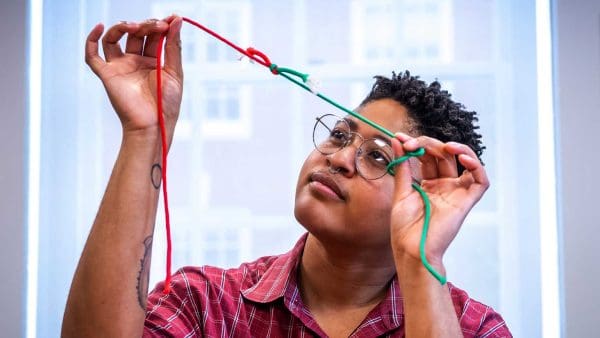
Sophomore Cameron Chenault studies whether bats “predict” their prey’s flight paths.
The hoary idiom “blind as a bat” is a misnomer. “No, they can see,” says sophomore behavioral biology and film double major Cameron Chenault. But since many of the flying mammals are nocturnal, they need some help catching prey in the dark. And for many bat species, that help is echolocation.
Chenault was awarded a Woodrow Wilson Fellowship to study the process of using sound to locate objects and to do that, she is working with a trio of big brown bats in the lab of Professor Cynthia Moss in the Department of Psychological and Brain Sciences. “Right now, we’re training them to focus on a tether that has a mealworm attached,” she says. “They have to vocalize at it and pay close attention to it and face the worm. They’re rewarded if they do that.”
This is just the first step toward what the researchers really want to discover: how much bats use ”prediction” when tracking an insect on the wing. There is a delay in the process of a bat signaling at something and then detecting the bounced back response. Do the airborne mammals compensate for this by estimating to some degree a bug’s flight path?
“We’re hoping to have the worm go behind an occluder, and then we can see if the bat looks to where the worm should come out,” Chenault says. “If it does, they must be predicting something in between. In the wild, if a bat is vocalizing directly at a moth, then there’s no guarantee that the moth is going to stay right in place. So, in between calls we think it’s figuring out where the moth might go. That’s what we’re looking at in the lab.”
Beyond the pure science of figuring out how bat brains use their built-in sonar, there could be practical lessons as well. The ultimate end game is to see if there are ways some form of echolocation could help the visually impaired or the elderly navigate their spaces. Part of Chenault’s fellowship involved flying to Brisbane, Australia, last summer to attend the conference of the International Congress of Neuroethology (researchers who study animal behavior and its underlying mechanistic control by the nervous system). There, she mingled with scientists studying bats as well as fish and bees. But for her part, she’s loyal to her choice of winged subjects. “Bats have a bad rap,” she says. “But they’re pretty nice and calm and easy little guys to work with.”




